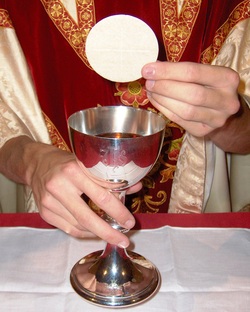The Sacramental Life: Holy Eucharist

Also known as the Lord's Supper or Holy Communion, the Eucharist is the center of our common worship as the church. At the Eucharist, we as Christians encounter the Real Presence of Christ. During the Eucharist we remember the sacrifice that Christ made on our behalf, and glory in our union with him in his resurrection. We celebrate the Eucharist frequently, as we believe it to be the spiritual food we need to sustain us in our spiritual journeys and everyday life. At St. Andrew's, we celebrate the Eucharist each Sunday, and on many of the major feast days of the church year.
In spite of the diversity of worship styles in the Episcopal Church, Holy Eucharist always has the same components and the same shape, divided into the Liturgy of the Word and the Liturgy of the Table. The Liturgy of the Word We begin by gathering the community through hymns and a prayer asking God to be with us as we worship. Next, we listen to Scripture, typically hearing four different readings from the Bible.: a reading from the Old Testament, a Psalm, something from the Epistles in the New Testament, and a reading from the Gospels. The psalm is recited or sung by the congregation. The priest proclaims the Gospel reading in the midst of the congregation, as a sign that Christ the Word is present in the midst of the church. A sermon interpreting the readings follows the Gospel. The congregation then proclaims the Nicene Creed, which has been the core statement of faith used by Christians since it was written in the 4th century. Next, the congregation prays together—for the Church, the World, and those in need. We thank God for all the good things in our lives, and finally, we pray for those who have died. The priest collects the Prayers of the People with a closing prayer. On most Sundays, the congregation confesses their sins before God and one another. This is a corporate prayer of confession of those things we remember personally, things we have done and those we have left undone. This is followed by a pronouncement of absolution, as God is always ready to forgive our sins. The congregation then greets one another with a handshake or a hug as a sign that they share "the peace of Christ.” The Liturgy of the Table After announcements are made, we sing a hymn while an offering of money is collected and is brought up to the Altar along with bread and wine. The priest sets the table, putting the wine into a cup called a chalice and putting the wafers of bread on a shallow dish called a paten. The priest then greets the people with "the Lord be with you", and the people respond "and also with you". Then the priest continues to lead the congregation in the Eucharistic Prayer. This prayer of thanksgiving to God recalls God's goodness in creating the world, in finding ways to reach to us in our sinfulness, and most importantly in God's gift of Jesus Christ to be our savior. The prayer continues with the words Jesus used at the Last Supper when he commanded the church to continue the meal in remembrance of him. We end by asking that the Holy Spirit descend, and make Christ truly present in the bread and the wine, that we may offer it and ourselves to God to the service of the kingdom of heaven. The congregation responds to this prayer with Amen or 'so be it', and we then pray the Lord's Prayer. The bread is broken, and the church comes forward to communion with the words "the gifts of God for the people of God." At the end of the Eucharist, the congregation prays once more in thanksgiving, and then is dismissed to go forth into the world to the life of service God. has called each of us to take up. "Go in peace, to love and serve the Lord!" |